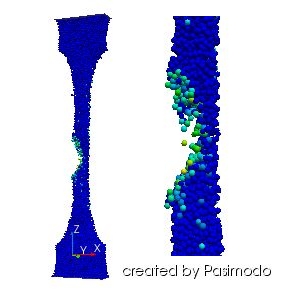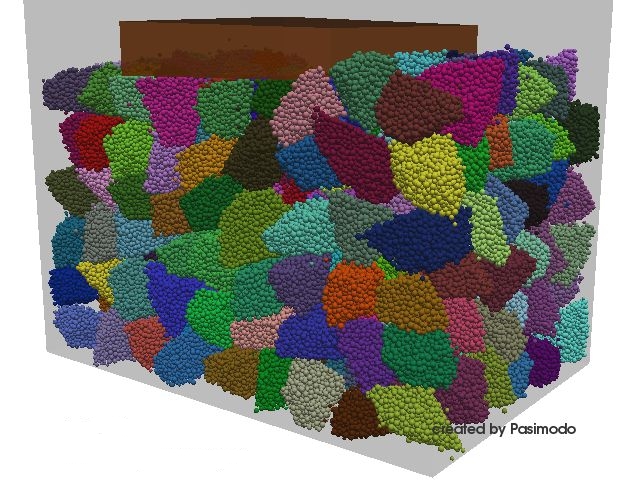 |
|
Subprojekt B.4 of the Collaborative Research Centre (SFB) 716
Dynamic simulation of systems with large particle numbers,
1st funding period 2007-2010
Succeeding project in the 2nd funding period 2011-2014: Simulation of Fracture Phenomena in Impact Loaded Granular Solids
Project Description

For granular media the crushing of macroscopic bodies is investigated by simulations.
The macroscopic bodies are constructed firstly from microscopic spheres and subsequently from convex polyhedra.
These microscopic particles are connected by force elements, which may break if a tolerable loading is reached.
As an application example the crushing and settlement processes of railway track ballast are
investigated by means of the Discrete Element Method (DEM).

The DEM as well as the methods of Molecular Dynamics are usually used for the simulation of systems of free particles
which interact by (contact) forces.
By means of appropriate approaches the DEM may be extended for the modelling of systems of bonded particles.
Thus, it is possible to represent e.g. elastic material behaviour or crack propagation and fracture processes in simulations.
For this purpose bilateral bonds between particles are introduced.
If a critical load is exceeded these bonds will break and are removed from simulation.
This corresponds to the preliminary definition of possible disconnection points of the material along the microscopic
particle boundaries, which are based on the breakable force elements.
In order to adjust fracture behaviour and failure modes in simulation to characteristics of real materials it is possible to include a progressive failure model with local damage accumulation.

Convex macro-bodies may be obtained e.g. by defining suitable section planes that cut the macro-bodies out of a predefined
sphere packing.
A possible approach is to define tangent planes based on ellipsoids that are used as bounding geometry of the macro-bodies.
The macro-bodies may also be described by means of a Delauny triangulation and the dual Voronoi diagrams.
The construction of suitable sphere packings, from which the macro-bodies are created, is also subject of further investigation.
Regular lattices are not sufficient as an initial configuration.
Hence, adequate irregular packings of spheres of different diameters have to be used.
These irregular lattices may be obtained by heaping up spheres in an appropriate way.
Another approach is to compact particles out of a dilute state by continuous increase of their radii.
Thereby, the way of controlling radii growth and the choice of a suitable radii distribution are of major importance.

At first, the mechanical properties of a single macro-body are investigated under simple loading conditions.
Stiffness and fracture behaviour of a macro-body are determined by means of uni- or multiaxial compression tests.
In particular, the dependence of the mechanical properties of the macro-bodies on the procedure of creation is verified.
The objective is to obtain macro-bodies, which correspond in their mechanical properties e.g. to real ballast pebbles.
A complete system is constructed from the macro-bodies.
To do so, the macro-bodies are inserted in appropriate test environments and optionally precompressed and equilibrated.
Subsequently, the settlement of the complete system as well as the fracturing of single macro-particles inside of the
collective are investigated.
The effects of different contact parameters and force laws of the bonds between the micro-particles are investigated as well.
It is also a matter of interest to what extend the geometry of the macro-bodies affects the simulation results.
In this process, it is always kept track of the comparison of simulation results with experimental data.
Publications
-
Ergenzinger, C.; Seifried, R.; Eberhard, P.:
Failure of Geomaterials Assessed using an Extended Discrete Element Method.
Proceedings of the Seventh International Conference on Engineering Computational Technology,
B.H.V. Topping, J.M. Adam, F.J. Pallares, R. Bru and M.L. Romero (Eds.),
Civil-Comp Press, Stirlingshire, UK,
Paper 136 (20 pages),
2010.
[http://dx.doi.org/10.4203/ccp.94.136]
-
Ergenzinger, C.; Seifried, R.; Eberhard, P.:
A Discrete Element Model to Describe Failure of Strong Rock in Uniaxial Compression.
Granular Matter, Vol. 13, No. 4, pp. 341-364, 2011.
[http://dx.doi.org/10.1007/s10035-010-0230-7]
Contact
|
|




